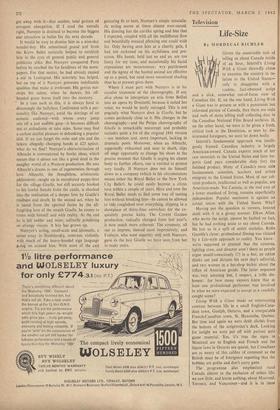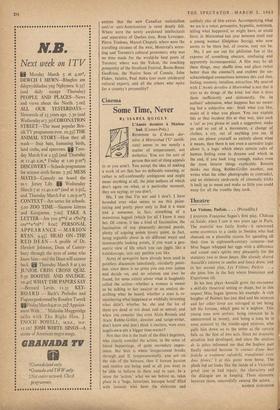Television
Life-Size
By MORDECAI RICHLER
GIVEN the unenviable task of telling us about Canada inside of an hour, Intertel's Living With a Giant shrewdly chose to examine the country in re- lation to the United States— Canadian life. lf, on the one hand, Living With a Giant was to present us with a panoramic but informed picture of Canada, then there are reels and reels of more ielling stuff collecting dust in the Canadian National Film Board archives. If, on the other hand, we were to be given a fresh, critical look at the Dominion, as seen by dis- interested foreigners, we were let down badly..
Intertel's fundamental approach was intelli- gently framed. Canadian industry is largely American-owned. Canada exports much of her raw materials to the United States and later im- ports (and pays considerable duty for) the finished product. Many of Canada's most able businessmen, scientists, teachers and artists emigrate to the United States. Most of our cul- tural products, intellectual as well as popular, are American-made. Yet Canada, at the real cost of a lower standard of living, remains superficially independent. Popular sentiment is against an actual union with the United States. Why?
Having put the question to viewers, 1ntertel dealt with it in a glossy manner. Elkan Allan, who wrote the script, cannot be faulted on fact, but he had nothing acute to say about Canada. He lost us in a spill of unfelt statistics. Rollo Gamble's clever, professional filming was vitiated by a Life-style approach to reality. You know: we're supposed to pretend that the cameras, lighting crew, and director aren't there as people argue unself-consciously (?) in a bar, an editor thinks out and dictates his next day's editorial, and two women in a hat-shop bicker about the influx of American goods. The latter sequence was, very amusing but, I suspect, a trifle dis- honest: for how many viewers knew that at least one professional performer was involved in what we were expected to accept as a candidly caught scene?
Living With a Giant made an entertaining contrast between life in a small English-Cana- dian town, Guelph, Ontario, and a comparable French-Canadian town, St. Hyacinthe, Quebec. But time and again we were dealt clichés from the bottom of the scriptwriter's deck. Looking for insight we were put off with parlour quiz game material. Yes, it's true the signs in Montreal are in English and French and the liquor laws in Ontario are quaint, but Canadians are as weary of this calibre of comment as the British must be of foreigners reporting that the bobbies are polite and don't carry guns.
The programme also emphasised rural Canada almost to the exclusion of urban life; we saw little, and learnt nothing, about Montreal, Toronto, and Vancouver—and it is in these centres that the new Canadian nationalism and/or anti-Americanism is most deeply felt. Where were the newly awakened intellectuals and separatists of Quebec (say, Rene Levesque, Pierre Trudeau, Marcel Chaput); where were the travelling circuses of the west, Montreal's wrest- ling and Toronto's cultural promoters; why was no time made for the would-be beat poets of Toronto; where was the Yukon, the touching pomposity of the Stratford Festival, Boom-Boom Geoffrion, the Native Sons of Canada, John Fisher, Juliette, Paul Anka (our most celebrated cultural export), and all the others who make for a country's personality?



































 Previous page
Previous page